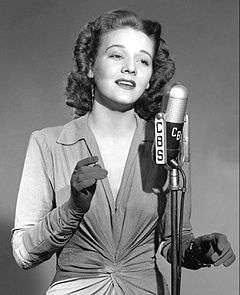Dorothy Shay
Dorothy Shay (April 11, 1921 – October 22, 1978) was an American popular comedic recording artist in the late 1940s and early 1950s, who later became a character actress. She was known as the "Park Avenue Hillbillie".
Dorothy Shay | |
|---|---|
 Dorothy Shay on Cresta Blanca Carnival circa 1940s | |
| Background information | |
| Birth name | Dorothy Sims |
| Born | April 21, 1921 Jacksonville, Florida, U.S. |
| Died | October 22, 1978 (aged 57) Santa Monica, California, U.S. |
| Genres | Pop Novelty |
| Occupation(s) | Singer Actress |
| Instruments | Vocals |
| Years active | 1945–1978 |
| Labels | Columbia, Capitol, Imperial |
Early life
Shay was born Dorothy Sims in Jacksonville, Florida. When she began her career as a 'straight' singer, she took vocal lessons to lose her Southern accent. She sang for the USO during World War II. Dorothy changed her name to "Shay" in order to not be confused with Ginny Simms, another performer of the day, choosing "Shay" to honor her mentor Betty Shay (later Betty Corday). While performing with Morton Gould and his orchestra, she performed an encore, "Uncle Fud", a hayseed novelty number that became popular and launched her solo singing career.[1]
"The Park Avenue Hillbillie"
She signed with Columbia Records and recorded a series of hit records. Her biggest hit was "Feudin' and Fightin'" in 1947.[2] In that same year, her album, "Dorothy Shay (The Park Avenue Hillbillie) Sings", was rated number 1 in Billboard magazine's Best-Selling Popular Albums.[3] She was the first female artist to have a number 1 album on the Billboard chart.
In her singing engagements, she performed dressed as a sophisticated urbanite while talking like a rural Southerner.
She was popular in clubs, radio and television. She played a nightclub singer, also named Dorothy, in the 1951 Abbott and Costello movie Comin' Round The Mountain. Shay was the musical guest on the second (television) season premiere of The Jack Benny Program in November 1951. She performed at Dwight D. Eisenhower's Inaugural Ball in 1953. She recorded for Capitol Records and Imperial Records where she recorded a rockabilly song titled "Hunky Dory".[4] In 1970 she appeared as Widow Krebs in the TV Western The Virginian in the episode titled "You Can Lead a Horse to Water."
Personal life
She was married briefly to Dick Looman from 1958-1959. After a period of inactivity in the 1960s, she returned to show business as a character actress in the 1970s. She had a recurring role as Thelma, first owner of the Dew Drop Inn, in the TV series The Waltons.[5]
Death
Shay died of a heart attack on October 22, 1978 in Santa Monica, California. Upon her death, the writers of The Waltons wrote her character off, with the mention that she sold the Dew Drop Inn and moved to California.[6]
Discography
| Title | Details | Peak |
|---|---|---|
| US [7][8] | ||
| Dorothy Shay Sings |
|
1 |
| Dorothy Shay Goes To Town |
|
1 |
References
- "Dorothy Shay". IMDb.com. Retrieved January 9, 2020.
- "Pop Chronicles 1940s Program #17".
- "Best-Selling Popular Record Albums". Billboard. October 25, 1947. Retrieved March 19, 2015.
- "dorothy shay records and CDs". MusicStack.com. Retrieved January 9, 2020.
- Dorothy Shay profile, imdb.com; accessed March 19, 2015.
- Profile, tv.com; accessed March 19, 2015.
- "The Billboard – The world's foremost amusement weekly: Best-Selling Popular Record Albums" (PDF). Billboard. August 2, 1947. p. 30. Retrieved March 21, 2019 – via AmericanRadioHistory.
- "The Billboard – The world's foremost amusement weekly: Best-Selling Popular Record Albums" (PDF). Billboard. January 24, 1948. p. 54. Retrieved October 29, 2019 – via AmericanRadioHistory.
External links
- The Dorothy Shay Fan Pages; no longer functional Nov 23, 2019.
- Big Bands and Big Names: Dorothy Shay, Bigbandsandbignames.com; accessed March 19, 2015.